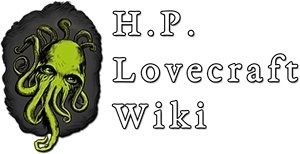mNo edit summary |
(Adding categories) |
||
| Line 19: | Line 19: | ||
{{DEFAULTSORT:Eltdown Shards}} |
{{DEFAULTSORT:Eltdown Shards}} |
||
[[Category:Mythos Books]] |
[[Category:Mythos Books]] |
||
| + | [[Category:Artifacts]] |
||
Revision as of 22:53, 3 August 2020
Background
Fragmentary writings found around 1891 C.E. in an early Triassic stratum of a gravel pit near Eltdown, U.S.A., by Doctors Dalton and Woodford and sent to an obscure Midwest museum at Baloin University, where they were kept locked away. A man named Gordon Whitney was able to partially translate them up to the 19th Shard (of 23 shards) before his demise. These translations appear to have been published in book form in the 19th century, but only the Van der Heyl copy is known to exist of this edition. The 23 shards of iron-hard grey clay are all shapes, ranging from the Fifth Shard: an oblong piece about 4 by 8 inches; to the fourteenth: a jagged, roughly triangular tablet nearly 20 inches across. Most of them were incomplete and some were mere fragments. The Nineteenth Shard is roughly 12 inches square, having a lower portion sheared off.
Further tablets bearing a striking resemblance were also found in the Triassic rock in Sussex (in 1905) and translated into English by the Rev. Arthur Brooke Winters-Hall (in 1917). These consist of 42 tablets 7 of which appear to be identical to the US find (the Eltdown finds are numbered 1-23, the Sussex finds are numbered 24-58; the duplicates are marked with an “s”. before the number, i.e. “s.8” is the Sussex version of Shard Eight.) Approximately 350 copies of this thick brochure were printed at the author's expense. These appear to also be known as The Sussex Fragments.
A third set of tablets are believed to have been passed down through the generations by a secret cult that also saved the Book of Eibon and the Pnakotic Manuscripts and their contents have been added to by the cult, although the original text is prehuman. Deals with prehuman and early human cultures. Shard Two contains a lengthy discussion of the Great Race.
The description "disturbing and debatable Eltdown Shards" seems to be particularly accurate!
Appearances in other fiction
There is a copy in the collection of the Library of St John the Beheaded. (ADJ: Doctor Who, Millennial Rites)
Behind the Mythos
The Eltdown Shards have a complex history. Invented by Richard F. Searight; Lovecraft took the name and ran with it, inventing a whole history for it in "The Challenge From Beyond". However Searight had written and alternative history in his own fiction. As Lovecraft was better known, most authors followed Lovecraft. As Searight's version became available in recent years, Joan C. Stanley tried to harmonise the information in her booklet Ex Libris Miskatonici: A Catalogue of Selected Items from the Special Collections in the Miskatonici University Library (Necronomicon Press, 1993). Searight's son, Franklyn has also written Mythos material following his father's guide, notably in the book Those Dreadful Eltdown Shards (H. Harken Productions, August, 2016) which collects al the fiction about the Shard in one place. Attempts have been made to separate and distinguish between the versions.
